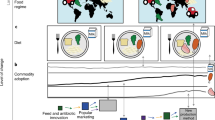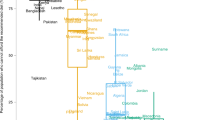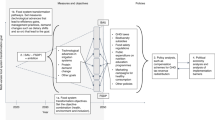Abstract
Future technologies and systemic innovation are critical for the profound transformation the food system needs. These innovations range from food production, land use and emissions, all the way to improved diets and waste management. Here, we identify these technologies, assess their readiness and propose eight action points that could accelerate the transition towards a more sustainable food system. We argue that the speed of innovation could be significantly increased with the appropriate incentives, regulations and social licence. These, in turn, require constructive stakeholder dialogue and clear transition pathways.
This is a preview of subscription content, access via your institution
Access options
Access Nature and 54 other Nature Portfolio journals
Get Nature+, our best-value online-access subscription
$29.99 / 30 days
cancel any time
Subscribe to this journal
Receive 12 digital issues and online access to articles
$119.00 per year
only $9.92 per issue
Buy this article
- Purchase on SpringerLink
- Instant access to full article PDF
Prices may be subject to local taxes which are calculated during checkout



Similar content being viewed by others
References
Springmann, M. et al. Options for keeping the food system within environmental limits. Nature 562, 519–525 (2018).
Frank, S. et al. Reducing greenhouse gas emissions in agriculture without compromising food security? Environ. Res. Lett. 12, 105004 (2017).
van Ittersum, M. K. et al. Can sub-Saharan Africa feed itself? Proc. Natl Acad. Sci. USA 113, 14964–14969 (2016).
Havlík, P. et al. Climate change mitigation through livestock system transitions. Proc. Natl Acad. Sci. USA 111, 3709–3714 (2014).
Rosegrant, M. W. et al. Food Security in a World of Natural Resource Scarcity The Role of Agricultural Technologies (International Food Policy Research Institute, 2014).
Foley, J. A. et al. Solutions for a cultivated planet. Nature 478, 337–342 (2011).
Rockström, J. et al. Planet-proofing the global food system. Nat. Food 1, 3–5 (2020).
Gao, L. & Bryan, B. A. Finding pathways to national-scale land-sector sustainability. Nature 544, 217–222 (2017).
Arneth, A. et. al. Summary for Policymakers. In Special Report on Climate Change and Land (eds Masson-Delmotte, V. et al.) (IPCC, WMO, 2019).
Searchinger, T. et al. Creating a Sustainable Food Future: a Menu of Solutions to Feed Nearly 10 Billion People by 2050 (Agency for International Development, 2018).
Willett, W. et al. Food in the Anthropocene: the EAT–Lancet Commission on healthy diets from sustainable food systems. Lancet 393, 447–429 (2019).
Pikaar, I. et al. Decoupling livestock from land use through industrial feed production pathways. Environ. Sci. Technol. 52, 7351–7359 (2018).
Walsh, B. J. et al. New feed sources key to ambitious climate targets. Carbon Balance Manag 10, 1–8 (2015).
Bumpus, A. & Comello, S. Emerging clean energy technology investment trends. Nat. Clim. Chang 7, 382–385 (2017).
Froggatt, A. & Wellesley, L. Meat Analogues: Considerations for the EU (Chatham House, 2019).
Hall, A. & Dijkman, J. Public Agricultural Research and Development in an Era of Transformation Vol. 1 (Independent Science Council of the CGIAR and Commonwealth Scientific and Industrial Research Organisation, 2019).
Selian, A. N. & McKnight, L. In The Pursuit of Human Well-Being (eds. Estes, R. & Sirgy, M.) 639–687 (Springer, 2017).
Tilman, D., Balzer, C., Hill, J. & Befort, B. L. Global food demand and the sustainable intensification of agriculture. Proc. Natl Acad. Sci. USA 108, 20260–20264 (2011).
Davis, K. F. et al. Historical trade-offs of livestock’s environmental impacts. Environ. Res. Lett. 10, 125013 (2015).
Campbell, B. M. et al. Agriculture production as a major driver of the Earth system exceeding planetary boundaries. Ecol. Soc. 22, 8 (2017).
Swinburn, B. A. et al. The Global Syndemic of Obesity, Undernutrition, and Climate Change: The Lancet Commission report. Lancet 6736, 1–56 (2019).
Mankins, J. C. Technology Readiness Levels, A White Paper (NASA, 1995).
Mankins, J. C. Technology readiness assessments: a retrospective. Acta Astronautica 65, 1216–1223 (2009).
Hirshhorn, S. et al. Final Report of the NASA Technology Readiness Assessment Study Team (NASA, 2016).
Alexandratos, N. & Bruinsma, J. World Agriculture Towards 2030/2050: The 2012 Revision ESA Working Paper No. 12–03 (FAO, 2012).
Swedish Research and Innovation Strategy for a Bio-based Economy (Swedish Research Council for Environment Agricultural Sciences and Spatial Planning, 2012).
National Bioeconomy Blueprint (Office of Science and Technology Policy, 2012).
El-Chichakli, B., von Braun, J., Lang, C., Barben, D. & Philp, J. Policy: Five cornerstones of a global bioeconomy. Nature 535, 221–223 (2016).
System Innovation: Synthesis Report (OECD, 2015).
Sánchez-Mejía, M. in Globalization and Health Inequities in Latin America (Malagón de Salazar, L. & Luján Villar, R.) 205–218 (Springer International Publishing, 2018).
Philp, J. The bioeconomy, the challenge of the century for policy makers. Nat. Biotechnol. 40, 11–19 (2018).
Building the Bioeconomy 4th edn (Pugatch Consilium, 2017).
Noack, A.-L. & Pouw, N. R. M. A blind spot in food and nutrition security: where culture and social change shape the local food plate. Agric. Human Values 32, 169–182 (2015).
Wellesley, L., Happer, C. & Froggatt, A. Changing Climate, Changing Diets: Pathways to Lower Meat Consumption (Chatham House, 2015).
Nyborg, K. et al. Social norms as solutions. Science 354, 42–43 (2016).
Greaker, M. & Midttømme, K. Network effects and environmental externalities: do clean technologies suffer from excess inertia? J. Public Econ. 143, 27–38 (2016).
Román, S., Sánchez-Siles, L. M. & Siegrist, M. The importance of food naturalness for consumers: results of a systematic review. Trends Food Sci. Technol. 67, 44–57 (2017).
Stilgoe., J., Owen, R. & McNaghten, P. Developing a framework for responsible innovation. Res. Policy 42, 1568–1580 (2013).
Mytelka, L. K. Competition, Innovation and Competitiveness in Developing Countries (OECD, 1999).
Snowden, D. J. The Cynefin Framework (Cognitive Edge, accessed 22 December 2018); https://cognitive-edge.com/
Asheim, G. B. et al. The case for a supply-side climate treaty. Science 365, 325–327 (2019).
Acemoglu, D., Akcigit, U., Hanley, D. & Kerr, W. Transition to clean technology. J. Polit. Econ. 124, 52–104 (2016).
Harstad, B., Lancia, F. & Russo, A. Compliance technology and self-enforcing agreements. J. Europ. Econ. Assoc 17, 1–29 (2019).
Ashford, N. in The Steilmann Report: The Wealth of People: An Intelligent Economy for the 21st Century 233–274 (2001).
Dempwolf, C. S., Auer, J. & D’Ippolito, M. Innovation Accelerators: Defining Characteristics among Start-Up Assistance Organisations (Small Business Administration, Office of Advocacy, Univ. Maryland, 2014).
Bryant, C. & Barnett, J. Consumer acceptance of cultured meat: a systematic review. Meat Sci. 143, 8–17 (2018).
de Boer, J. & Aiking, H. Prospects for pro-environmental protein consumption in Europe: cultural, culinary, economic and psychological factors. Appetite 121, 29–40 (2018).
Vanhonacker, F., Van Loo, E. J., Gellynck, X. & Verbeke, W. Flemish consumer attitudes towards more sustainable food choices. Appetite 62, 7–16 (2013).
Preston, F. & Lehne, J. A Wider Circle? The Circular Economy in Developing Countries (Chatham House, 2017).
Mazzucato, M. From market fixing to market-creating: a new framework for innovation policy. Ind. Innov 23, 140–156 (2016).
Acknowledgements
M.H., D.M.-D., J.P.J., J.R.B., G.D.B., M.T.C., C.D., C.M.G., M.G., C.L.M., J.N., M.B.P., M.J.R. and S.M.S. acknowledge funding from the Commonwealth Scientific and Industrial Research Organisation; P.T., B.M.C., A.J. and A.M.L. acknowledge funding from the CGIAR Research Program on Climate Change, Agriculture and Food Security (CCAFS), which is carried out with support from the CGIAR Trust Fund and through bilateral funding agreements (see https://ccafs.cgiar.org/donors). The views expressed in this document cannot be taken to reflect the official opinions of these organizations. B.L.B. acknowledges funding from the NAVIGATE project of the European Union’s Horizon 2020 research and innovation programme under grant agreement 821124, and by the project SHAPE, which is part of AXIS, an ERA-NET initiated by JPI Climate, and funded by FORMAS (SE), FFG/BMWFW (AT), DLR/BMBF (DE, grant no. 01LS1907A-B-C), NWO (NL) and RCN (NO) with co-funding by the European Union (grant no. 776608); P.P. acknowledges funding from the German Federal Ministry of Education and Research (grant agreement no. 01DP17035); M.C. acknowledges funding from the Wellcome Trust, Our Planet Our Health (Livestock, Environment and People), award number 205212/Z/16/Z; J.S.G., P.S. and P.C.W. acknowledge funding from the Belmont Forum/FACCE-JPI DEVIL project (grant no. NE/M021327/1); A.P. acknowledges funding from the NAVIGATE project of the European Union’s Horizon 2020 research and innovation programme under grant agreement 821124, and by the project SHAPE, which is part of AXIS, an ERA-NET initiated by JPI Climate, and funded by FORMAS (SE), FFG/BMWFW (AT), DLR/BMBF (DE, grant no. 01LS1907A-B-C), NWO (NL) and RCN (NO) with co-funding by the European Union (grant no. 776608).
Author information
Authors and Affiliations
Contributions
M.H., P.K.T., D.M.C., J.P. and J.B. designed the research. M.H., P.K.T., D.M.C., J.P., A.H., B.L. and K.N. wrote the manuscript. M.H., P.K.T., D.M.C. J.P., J.B., C.G., K.D. and J.N. analysed data. All authors contributed data and edited the paper.
Corresponding author
Ethics declarations
Competing interests
The authors declare no competing interests.
Additional information
Publisher’s note Springer Nature remains neutral with regard to jurisdictional claims in published maps and institutional affiliations.
Supplementary information
Supplementary Information
Supplementary methods, discussion and Tables 1,2.
Rights and permissions
About this article
Cite this article
Herrero, M., Thornton, P.K., Mason-D’Croz, D. et al. Innovation can accelerate the transition towards a sustainable food system. Nat Food 1, 266–272 (2020). https://doi.org/10.1038/s43016-020-0074-1
Received:
Accepted:
Published:
Issue Date:
DOI: https://doi.org/10.1038/s43016-020-0074-1
This article is cited by
-
Environmental mitigation potential of waste-to-nutrition pathways
Nature Sustainability (2025)
-
Degrowth as a plausible pathway for food systems transformation
Nature Food (2025)
-
Emerging alternatives to coffee, cocoa and palm oil deserve a spot on the research agenda
Nature Food (2025)
-
Modelling six sustainable development transformations in Australia and their accelerators, impediments, enablers, and interlinkages
Nature Communications (2024)
-
Maize yield prediction and condition monitoring at the sub-county scale in Kenya: synthesis of remote sensing information and crop modeling
Scientific Reports (2024)



